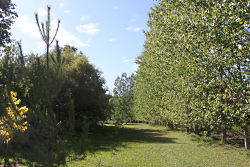
Courtesy and Copyright Ron Hellstern, Photographer
Wohlleben states that trees communicate with each other by using scents. It seems that various trees can release toxins into their leaves when being eaten by herbivores looking for a meal. But these trees also warned nearby relatives of the same species by releasing gases as a signal they were being invaded. Those neighboring trees quickly pumped those same toxins into their leaves to prevent an oncoming attack.

Courtesy and Copyright Ron Hellstern, Photographer
These warnings to neighboring trees aren’t always carried through the air. Consider days when there is no wind. They can also be sent using chemical signals sent through the fungi around their root tips. Serious problems can occur when trees lose these skills as well as their ability to defend themselves. This is one important reason to maintain undisturbed sections of old-growth forests. Wohlleben also cites a study in Australia when it was observed that the roots of grain seedlings oriented their root tips toward the origin of sound frequencies of 220 hertz. Can trees taste, smell, respond to electrical signals, and hear sounds? It seems incredible, but how much do we really know about trees?
Consider the many benefits trees provide for humanity and other life forms: Of course they can be used for building or fuel, but they can raise property values by as much as 15%; they take in Carbon Dioxide for growth and release Oxygen; they help moderate the climate; they purify the air of toxic substances; they produce fruit and nuts; they provide habitat for insect-eating birds; they provide cooling summer shade and reduce heat-islands in urban settings; they reduce noise levels and light pollution for scenic night skies; they provide soil stability to reduce erosion; and they provide scenic green-screens for privacy. Research has also shown that urban tree areas have lower crime rates, and hospitals report that recovery from physical or mental issues are improved and hastened by having trees in their landscape.
There is much more to learn from the book, The Hidden Life of Trees. And Fall and Spring are the ideal times to plant these quiet, scenic wonders.
This is Ron Hellstern, and I am Wild About Utah.
Credits:
Images: Courtesy & Copyright Ron Hellstern
Lead Audio: Courtesy and Copyright
Text: Ron Hellstern, Cache Valley Wildlife Association
Additional Reading
Hellstern, Ron, The Hidden Life of Trees, Wild About Utah, August 26, 2019, https://wildaboututah.org/the-hidden-life-of-trees/
Wohlleben, Peter, The Hidden Life of Trees, Jane Billinghurst, Translator, Greystone Books Ltd., 2016, https://www.amazon.com/Hidden-Life-Trees-Illustrated/dp/177164348X
Wohlleben, Peter, The Hidden Life of Trees – The Illustrated Edition, Jane Billinghurst, Translator, Greystone Books Ltd. 2018, https://www.amazon.com/Hidden-Life-Trees-Illustrated/dp/177164348X
Noe, Alva, A Web Of Trees And Their ‘Hidden’ Lives, National Public Radio, September 23, 2016, https://www.npr.org/sections/13.7/2016/09/23/494989594/a-web-of-trees-and-their-hidden-lives
Kuhns, Michael, https://upcolorado.com/utah-state-university-press/item/2130-a-guide-to-the-trees-of-utah-and-the-intermountain-west
